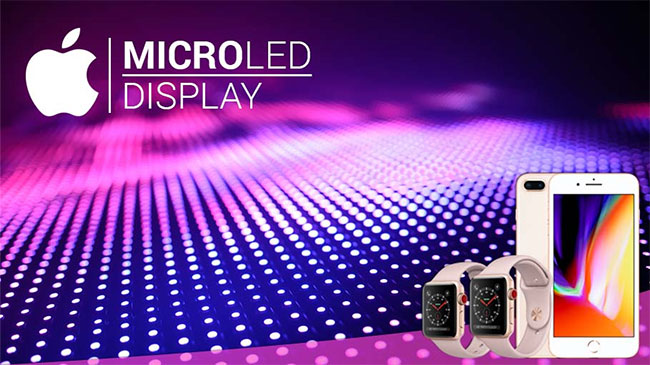What is MicroLED? What is MicroLED different from OLED?
MicroLED display technology has been very concerned, since Samsung launched the MicroLED TV series at CES 2020 earlier this year. Unsurprisingly, both Samsung and LG announced plans to end production of LCD panels later this year. Instead, these 'tech giants' will focus on quantum dot monitors.
Terms of TV technology
LED TV is nothing more than LCD screen with improved LED backlight. These LED TVs are nothing like OLED TVs. Quantum dot TVs are basically LED TVs equipped with a plastic sheet filled with nanoparticles.
In general, LCD TVs, LEDs and quantum dots differ primarily in backlight technology.
What is MicroLED?
To understand MicroLED, you first need to know the backlight.
 MicroLED screen
MicroLED screen One of the reasons LCDs are considered obsolete and does not meet current expectations is because they need a backlight to work. This backlight makes the size of the product larger, and can create uneven brightness, color problems and many other weaknesses.
OLEDs, by contrast, are self-emitting, meaning they can create their own light. That means OLED TVs offer perfect blacks, striking colors and allow product designers to create exceptionally thin and beautiful devices. However, OLEDs made with organic compounds, over time, begin to degrade and in the long run, potentially making them problematic.
MicroLED has everything great about OLED - self-emitting technology, perfect blacks and striking colors - while eliminating organic compounds. That means MicroLED panels are extremely thin and have the ability to provide superior viewing angles. In addition, they are independent of organic compounds, so MicroLED panels will be cheaper than OLED. On top of that, MicroLED can technically deliver brighter images than OLED.
What is MicroLED different from OLED?
MicroLED and OLED have their advantages and disadvantages.
The manufacturing factor is arguably the most important advantage of OLED. According to Soneira, manufacturers can produce an OLED screen containing millions of subpixels at the same time. The result is a striking image with infinite contrast ratio, perfect blacks and great viewing angles. On top of that, OLED can provide extremely bright screens.
 Conventional LEDs (left) compared to smaller modules for OLED (center) and MicroLED (right)
Conventional LEDs (left) compared to smaller modules for OLED (center) and MicroLED (right) Meanwhile, producing a MicroLED with a specially created subpixel is extremely difficult. And according to Soneira, even the latest robot manufacturing technology does not make that process simpler. Until companies can fix this problem, OLEDs are clearly in a better position.
However, once the MicroLED screen is produced, the results will be very different.
OLED's dependence on organic compounds will eventually lead to "a decrease in brightness over time". Worse yet, when OLED displays are used for a long time, it's possible that some compounds will lose brightness faster than others, creating uneven images.
In contrast, the LEDs in MicroLED are not only brighter but also don't lose brightness over time due to natural degradation. In the long run, MicroLED is capable of keeping image quality and maintaining brightness, while OLEDs manufactured at the same time begin to fade. In addition, MicroLED has a much higher energy efficiency than OLED.
Last but not least, MicroLED is likely to be made in a thinner size than OLED. This can give product designers more control over the design. But in general, OLED and MicroLED will provide almost similar images in a short time, where MicroLED produces brighter images.
 What is DIMM (Dual In-line Memory Module)?
What is DIMM (Dual In-line Memory Module)? Learn about the CSEC ITSG-06 method
Learn about the CSEC ITSG-06 method Difference between NFC and RFID
Difference between NFC and RFID What is SIM-jacking?
What is SIM-jacking? What is a RADIUS Server? How does RADIUS Server work?
What is a RADIUS Server? How does RADIUS Server work? What is web scraping? What is Web Scraping used for?
What is web scraping? What is Web Scraping used for?